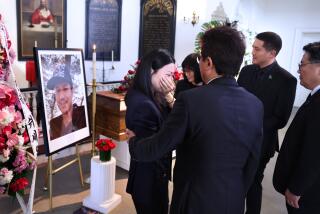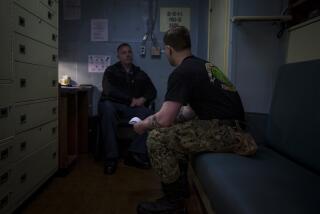In SEAL sniper Chris Kyle’s shooting, PTSD’s complicated presence
- Share via
Four letters, “PTSD,” have hung over Eddie Ray Routh since the day he was accused of killing Chris Kyle, a famed Navy SEAL sniper, and perhaps a little unfairly so: Kyle probably had PTSD himself.
The fragments of information presented about Routh, a 25-year-old Marine reservist, have been indelible thus far. Iraq war veteran. Listless and unemployed.
There’s Routh: hospitalized multiple times since returning home, at one point reportedly threatening the lives of his family; also having been found shoeless and drunk by the police.
There’s Routh: hospitalized another time because a friend in north Dallas was afraid he would hurt himself.
There’s Routh: hospitalized as recently as a week and a half ago, according to a 911 call his sister made Saturday, in which she said her brother had just confessed to killing Kyle and another man at a gun range southwest of Fort Worth.
“He says that he killed two guys, they went out to a shooting range -- he’s all crazy, he’s like psychotic,” his sister, Laura Blevins, said in the 911 call obtained by local media. Then she put her husband on the call.
“He was talking kind of babble.... He’s been known to drink in the past, but he was recently diagnosed with PTSD,” he said.
“With what?” the dispatcher responded.
“PTSD.”
“PTSD?” she asked again.
“Post-traumatic stress disorder,” Blevin’s husband said, “and he’s been acting a little weird. He just got out of a mental hospital, actually.”
Yet an expert with the disorder thinks Routh’s afflictions were more complicated than PTSD, which has affected thousands of veterans of the wars in Iraq and Afghanistan, which perhaps includes Kyle himself, a survivor of four deployments to Iraq and involvement in multiple major battles, who said he had killed at least 160 people as a sniper.
In Kyle’s book, “American Sniper: The Autobiography of the Most Lethal Sniper in U.S. Military History” -- whose sales have ballooned since his death -- Kyle chronicles not only his combat experiences but the familiar, anxious emptiness that hits many veterans after the action ends.
“I had time to relax, but I couldn’t,” Kyle wrote of the end of his final tour in Iraq. “Instead, I’d lie on my bed thinking about everything I’d been through -- getting shot especially. I relived the gunshot every time I lay down to rest. My heart thumped hard in my chest, probably a lot harder than it had that night in Sadr City. Things seemed to go downhill in the few days after we got back from our border patrol. I couldn’t sleep. I felt very jumpy. Extremely jumpy. And my blood pressure shot up again, even higher than before. I felt like I was going to explode.”
In Kyle’s book, a combat paean to survival, struggle, and death, he never used “PTSD” or “stress.”
But he wrote of getting drugs prescribed by doctors, succumbing to depression at home, missing killing bad guys, resenting his wife and falling into drink: He crashed his truck one night before starting to turn things around and easing back on booze.
“He clearly suffered from his own PTSD,” said Harry Croft, a San Antonio psychiatrist who has studied thousands of veterans with post-traumatic stress disorder, after reviewing portions of Kyle’s book. “You know, the people I found who do the best are those who help support other people. I think Kyle’s foundation was probably a way of helping himself in addition to helping others. And wouldn’t you figure that out of that, this happens. It’s tragic.”
Kyle worked with a nonprofit group, FITCO Cares, to get returning veterans workout equipment. He had also written about using gun ranges as a kind of therapy for returning veterans, in which he’d give jokey tough-love between stories and beer. It’s on such a trip with Routh that police think Routh turned a semiautomatic pistol on Kyle and one of Kyle’s friends, Chad Littlefield, 35.
After his arrest, Routh fought with guards in jail, was Tasered and placed in restraints. “He’s been on suicide watch ever since he’s been here,” Erath County Sheriff Tommy Bryant told the Los Angeles Times on Wednesday.
“He hasn’t caused any more problems since then,” Bryant said, but added, “On Tuesday, he refused to see his attorney and family that came to visit him.”
Croft, the traumatic stress specialist who’s been following Routh’s case, suspected that Routh was experiencing something beyond PTSD, at least from the scraps of information that have slid into public view.
“So here’s a guy who’s been hospitalized [at least] twice now, not just threatening suicide and violence, but the point somebody put him in the hospital for the protection of himself and other people,” Croft said. “This is not simply PTSD. This was PTSD ‘plus.’ And the ‘plus’ was alcohol, and the ‘plus’ was what sounds like probably some disorganized thinking and behavior -- did that represent psychosis? We don’t know what his thoughts were.”
Croft said that Kyle probably had “the best of intentions and the best of heart,” but taking Routh to a gun range may not have been the right therapeutic call, given Routh’s instability.
“I think what Kyle was doing was trying to support him, befriend him … but what this man needed worst of all was real treatment,” Croft said.
Meanwhile, tributes to Kyle continue to pour in.
After Kyle’s death, FITCO Cares issued “A Promise to Fight PTSD” and raise awareness about the disorder. A memorial service for Kyle was scheduled for Monday at Cowboy Stadium in Arlington, Texas.
The Naval Special Warfare Command, which oversees the Navy SEALS, lamented Kyle’s death in a statement from Rear Adm. Sean Pybus. Pybus praised Kyle’s “extraordinary skill and courage” and said “we will help honor Chris and support his family in appropriate ways in the coming weeks.”
On Wednesday, a Navy spokesman declined to confirm Kyle’s widely cited claim to have the most confirmed kills in U.S. military history, saying the military does not discuss “operational data.”
“The Navy credits me with more kills as a sniper than any other American service member, past or present,” Kyle wrote in his book. “I guess that’s true. They go back and forth on what the number is. One week, it’s 160 (the ‘official’ number as of this writing, for what that’s worth), then it’s way higher, then it’s somewhere in between. If you want a number, ask the Navy — you may even get the truth if you catch them on the right day.”
ALSO:
Boy Scouts postpone decision on admitting gays
Police: Concealed-carry coach who killed student is a ‘victim’
Boy held in Alabama bunker celebrates release -- and 6th birthday
More to Read
Sign up for Essential California
The most important California stories and recommendations in your inbox every morning.
You may occasionally receive promotional content from the Los Angeles Times.














